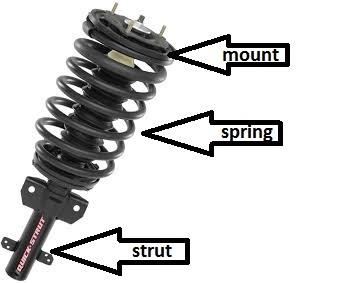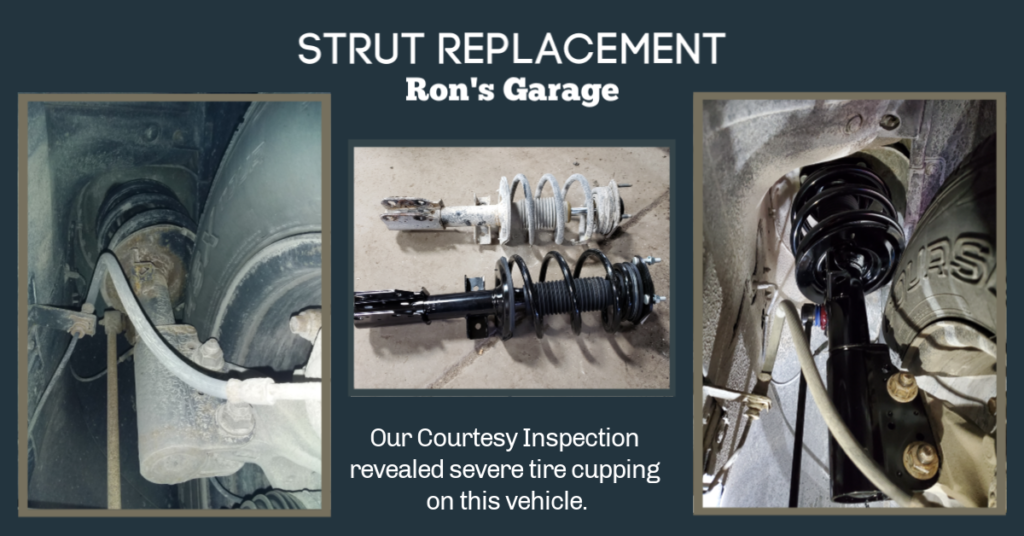13 Jan How to tell if your Struts/Shocks need to be replaced
What exactly are Struts/Shocks?
Struts and Shocks are suspension components whose main purpose is to stabilize your vehicle as you’re driving. Here in Michigan, especially in the winter, drivers swerve around potholes frequently as we drive on our less than perfect roads. What happens when you hit a pothole? Your Struts/Shocks absorb the bounce so that the passengers have as little impact as possible. Essentially, they balance out your vehicle and allow for a smooth ride.
What is the difference between Struts and Shocks?
Struts/Shocks are often referred to interchangeably, and while they are similar, they are not the same. Typically vehicles will have either Struts or Shocks, but on occasion, it may have Struts in the front and Shocks in the rear. Shocks reduce the movement by slowing down and stabilizing the energy caused by every day driving. The Strut sits inside of the coil spring, which absorbs the bulk of the bouncing, while the Strut then minimizes any bouncing after that while holding your vehicle steady.

How often do Struts need to be replaced?
Each manufacturer recommends replacing your vehicles’ Struts/Shocks at different intervals, however, on average you can count on replacing them every 40,000-100,000 miles unless they are showing any signs of wear. There are several symptoms that would suggest your Struts/Shocks need to be replaced earlier than the manufacturer’s recommended interval.
Ron’s Garage places a high emphasis on vehicle safety, so inspecting your suspension components is something that we do at every service appointment, and at the bare minimum, we recommend having them inspected every 25,000 miles. We will test drive your vehicle to determine how well it’s performing during turns, while changing lanes, over speedbumps, at high speeds, etc. and then we’ll bring it back to the shop for a visual inspection and to check for any oil leaking from them.

Warning Signs that my Struts/Shocks need to be replaced.
There are a number of factors that could impact your Struts/Shocks, such as age, rust, driving on rough roads, or driving with heavy loads. Here are some of the things that will give us a red flag.
- Oil leakage coming from your Struts/Shocks
- Excessive bouncing after hitting a bump
- Steering wheel is stiff
- Difficulty steering on bumpy roads or while turning the wheel – “swaying” from side to side or “leaning” to one side or another
- Harsh, bumpy, or shaky ride – feels unstable at high speeds
- If the front end “dives” down while braking
- If your tires show signs of “cupping” or uneven wear patterns
- Obvious signs of damage/broken parts
What will worn out Struts/Shocks will do to your vehicle?
Without the support of your Struts/Shocks, your vehicle will bounce every time you turn or hit a pothole or speed bump. In turn, this excessive movement can wear down your tires or other suspension components such as your ball joints, control arm bushings, stabilizer bar links or tie rod ends. It could even impact your steering ability. Since suspension components can be pretty expensive, it’s best to replace these quickly as having one faulty part can negatively affect other parts as well.
Helpful Tips when replacing my Struts/Shocks
Your Struts/Shocks should always be replaced in pairs. Since the main goal of your Struts/Shocks is to stabilize your vehicle, it only makes sense to replace both sides of the vehicle at the same time to make it even. You can either do the Front Struts/Shocks or the Rear Struts/Shocks, but never either the left or right side.
Whenever replacing any suspension components, Ron’s Garage recommends performing an Alignment. This will ensure that your new parts are properly supporting your vehicle and won’t negatively impact your tires or other suspension components if misaligned.
If you suspect that your vehicle may need new Struts/Shocks, we are happy to take a look! Call 734-662-8379 to schedule an appointment.

